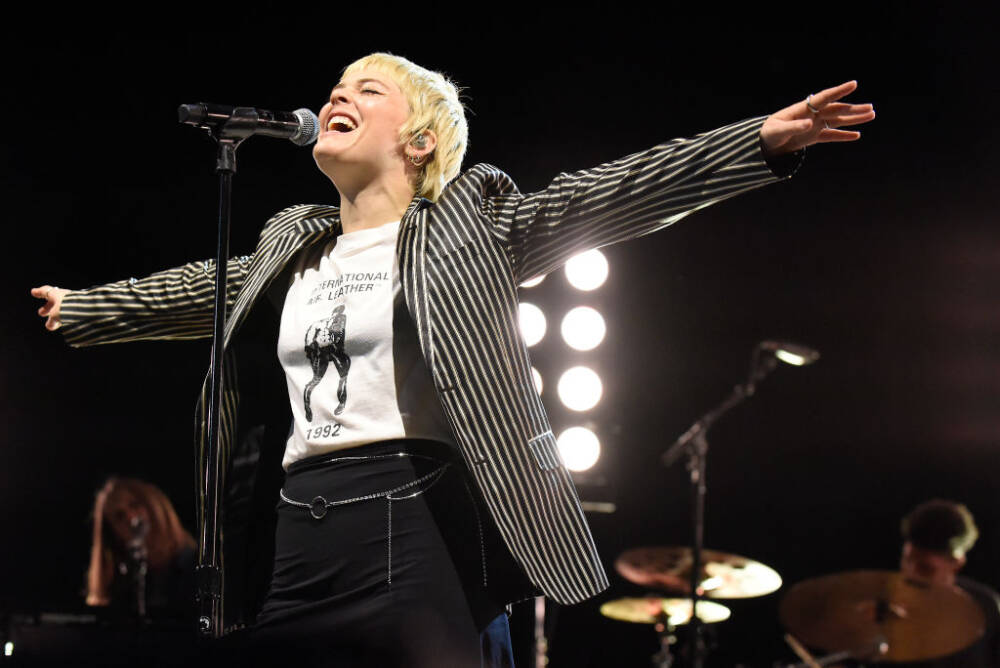Advertisement
Commentary
In Maggie Rogers, I saw the ghost of Edie Sedgwick

I recently attended a concert by the 28-year-old Harvard-educated pop singer Maggie Rogers, whose career I’ve been tracking ever since Pharrell Williams compared her to Wu Tang Clan and Stevie Wonder — pop gods much closer to my age. But to tell the truth, I went to see Rogers because my college-age daughter knows every word to every Rogers song. It was a sold-out crowd of 3,500, and I’m sure my wife and I were the oldest in attendance.
But there on the huge video screen behind the 60-foot stage hovered someone much older, and long dead: Edie Sedgwick.
Or rather it was Maggie Rogers as Edie Sedgwick — who would have turned 80 this year. Rogers’ face flickered in the grainy black-and-white video, which was similar to the trailer for her latest album, “Surrender.” The video seemed archival, like a 16mm reel made decades before Rogers’ birth. She stared silently and rather blankly at the camera, without moving much, occasionally blinking very slowly. Rogers’ long hair — once a distinguishing characteristic of her pop persona — was cut short, pixie-like. She could easily be mis-recognized as Sedgwick in one of the famous “screen tests” Andy Warhol made of her in her heyday in 1965. Maggie Rogers was clearing conjuring the ghost of Edie from a very different time long ago. I couldn’t help but wonder why?
It’s strange, this long afterlife of Edie Sedgwick. When she died of a barbiturate overdose in 1971, in a shabby apartment in Santa Barbara, Sedgwick was already almost completely forgotten. Her estate consisted of $3,807.73 and 65 shares of Western Independent Corporation, a local bank. Only a few hundred people had seen the films she made with Warhol, and he would soon take them all out of circulation. A California District Court deemed her “likeness” — images of her face, her life story, and such — worthless at the time of her death.
But now, Sedgwick’s image appears on t-shirts, posters and tote bags. She is the subject of websites, Instagram accounts and Pinterest pages. Her tragic life story — born into a once-prominent New England family and ruled over by a monstrous father (who psychologically and sexually molested his daughters and rejected one of his gay sons), only to become, at age 21, Warhol’s most memorable superstar, briefly, before collapsing into drug abuse, institutionalization, and early death -- has been the subject matter of books and films, pop songs and podcasts. It’s an enduring shared fascination that, with Rogers as exhibit A, shows no signs of fading out.
Of course, the cult of Edie Sedgwick in part grows from her association with Warhol. We all live in the Age of Warhol — no other artist has so thoroughly understood, predicted and contributed to our socially-networked, image-obsessed existence. But to attribute all the power to Warhol doesn’t give Sedgwick much agency, and doesn’t explain why she, of all of Warhol’s many superstars, is a household name.
Indeed, she was never allowed much agency even at the height of her fame in the '60s. Warhol gave her starring roles in a series of films he called “The Poor Little Rich Girl Saga.” Bob Dylan, if legend is to be believed, took Sedgwick as inspiration for “Just Like a Woman” (wherein each chorus the woman of the title, again and again, “breaks just like a little girl”). Lou Reed wrote “Femme Fatale” about her.
But maybe this condescending typecasting by Warhol, Dylan and Reed was their attempt to defensively render inert a certain power these men sensed in Sedgwick: she was a lot like them, only a woman.
Whenever I see Sedgwick’s image, I immediately think of two quotations. The first is a comment by the Beat poet Gregory Corso, in response to an interview question about the absence of rebellious female writers in the 1950s: “There were women, they were there. I knew them, their families put them in institutions, they were given electric shock. In the '50s if you were male you could be a rebel, but if you were female your families had you locked up.”
The second quotation I think of is from Sedgwick herself to The New York Times in 1965. It deepens and transforms Corso’s observation: “It's not that I'm rebelling,” Sedgwick said, “It's that I'm just trying to find another way.”
[Sedgwick] was trying to create something new in the world, “to find another way.” She was, in other words, trying to become an artist.
Like Warhol, Dylan, and Reed, Edie Sedgwick wasn’t simply rebelling for the sake of rebellion (although she did suffer the electric shocks). Instead, she was trying to create something new in the world, “to find another way.” She was, in other words, trying to become an artist.
Her art was ephemeral, perhaps because more ephemeral mediums gave her freedom not allowed women in more traditional forms. Her art was a look, from the way she shadowed her eyes and silvered her hair to the dance leggings and thrift-store jewelry she combined into an exquisite, influential style. It was a dance — the unique way she moved her body at parties and in films — that people began to call “the Sedgwick.” Perhaps most of all, it was her performance of her sexuality — the way she refused the types of both seductress and sweetheart, making herself, somehow, simultaneously androgynous, libidinal and nymph-like. These were disruptions but also attempts to make a world she could flourish within. That’s what artists do.
I suspect that it is this desire to “find another way” to be an artist that draws people to Sedgwick today — especially young artists like Maggie Rogers. When I saw Rogers perform in the sold-out concert, she strutted across the stage like a great rock star, and her voice blew the roof off the joint. But between songs, she spoke quietly to the audience in the same voice you use when you meet a friend for coffee. She spoke about life during COVID and feeling numb and disconnected. She spoke about how the songs on her new album weren’t about surrendering a battle but about surrendering to new feelings and forces that might take you in new directions.
There is always great risk in such “surrenderings” — when you open yourself to another way. I’m not confident that this kind of surrender is any easier than when Edie first took her place before Warhol’s movie camera nearly 60 years ago, but she is still an inspiring guide. As the closing song, Rogers sang “A Different World” — as if to capture the idea of trying to find another way.


